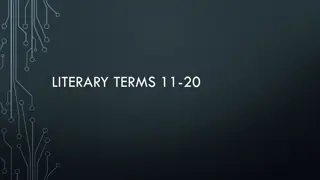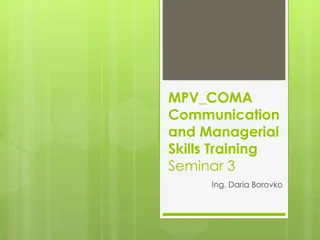Communication Styles and Advantages of Written Communication
Communication is the process of sharing information through various mediums like verbal, non-verbal, written, and visual. Understanding the communication cycle and different styles - verbal, non-verbal, visual, and written - is crucial for effective communication. Written communication offers advant
10 views • 22 slides
Charles Dickens: Humor, Irony, and Language Play
Explore the world of Charles Dickens through his unique humor, irony, and language play. Delve into his novels categorized as Comedies of Manners and Comedies of Humours, with a focus on the diverse characters he created. Discover how Dickens skillfully evokes strong emotions to tackle serious theme
7 views • 27 slides
Verbal Prescriptions in Pharmacy Practice
This comprehensive guide provides insights into obtaining verbal prescriptions, necessary information in a verbal prescription, types of written verbal prescriptions, acceptable sources for verbal prescriptions, authorized personnel to accept verbal prescriptions, laws regarding interns and verbal p
0 views • 18 slides
Communication and Sign Language
Communication is the vital process of exchanging information, ideas, and emotions through various channels such as speech, signals, and writing. This includes verbal and non-verbal communication, where sign language plays a crucial role. Effective communication depends on the sender, message, channe
1 views • 31 slides
Communication Skills and Types
Communication is the exchange of information through various mediums like speaking and writing. It can be verbal or non-verbal. Verbal communication involves oral and written forms, while non-verbal communication includes body language and appearance. Each type has its own advantages and drawbacks,
1 views • 13 slides
Irony, Paradox, Oxymoron, and Parallelism in Frankenstein
Exploring the concepts of irony, paradox, oxymoron, and parallelism in Mary Shelley's "Frankenstein." The discussion covers different types of irony such as situational, verbal, and dramatic, highlighting instances from the novel. Additionally, the concept of paradox is examined, showcasing statemen
0 views • 16 slides
Verbal and Non-Verbal Tests
Verbal and non-verbal tests serve different purposes in assessing intelligence and skills. Non-verbal tests utilize images and diagrams to measure reasoning abilities without requiring reading or writing. Verbal tests, on the other hand, assess language-based skills through reading, writing, or oral
0 views • 14 slides
Modes of Communication and Verbal Messages
Communication occurs through verbal and nonverbal modes, with messages having denotative and connotative meanings. Verbal messages vary in directness, affecting the effectiveness of communication. Indirect messages offer advantages such as politeness and avoiding offense, but can also lead to misund
0 views • 64 slides
Symbolism and Irony in Literature
Symbolism in literature involves using symbols to convey deeper meanings beyond the literal sense, adding layers of interpretation for readers. Common symbols like doves, red roses, and sunrises represent peace, love, and new beginnings, respectively. Irony, on the other hand, includes situational,
0 views • 6 slides
Irony, Paradox, and Oxymoron in Figure of Speech
Exploring the concepts of irony, paradox, and oxymoron through examples and exercises in a lesson designed for 5th-grade students. Students learn to identify these figures of speech that show contrast and contradiction, enhancing their understanding of language and expression. The lesson provides ex
3 views • 8 slides
Summary and Irony in "The Open Window" by Saki
Framton Nuttel, seeking peace in the countryside, encounters a series of unsettling events at his friend's home. The niece spins a tale about the open window, leading to a chilling twist that heightens Framton's anxiety. Irony weaves throughout the narrative as the supposedly tranquil setting exacer
0 views • 8 slides
The Importance of Nonverbal Communication in Communication Skills
Nonverbal communication plays a crucial role in conveying messages and signals through platforms like eye contact, facial expressions, gestures, posture, and spatial distance. It includes appearance, body language, silence, time, and space. This form of communication can significantly impact the rec
1 views • 16 slides
Irony in Verbal, Dramatic, and Situational Contexts
Explore the nuances of verbal, dramatic, and situational irony through examples and explanations. Verbal irony involves saying something different from what is meant, often using humor like puns. Dramatic irony occurs when the audience knows something the characters don't, creating suspense. Situati
0 views • 12 slides
Literary Devices: Allusion, Foil, Hyperbole, Idiom, Irony, Metaphor
Explore key literary terms including allusion, foil, hyperbole, idiom, irony, and metaphor. Learn how these devices enhance storytelling by creating depth, contrast, exaggeration, cultural nuances, and symbolic meaning within literature.
1 views • 14 slides
Literary Elements Explained: Setting, Protagonist, Antagonist, Irony, Symbolism, Theme
Exploring various literary elements such as setting, protagonist, antagonist, irony, symbolism, and theme using examples from works like "There Will Come Soft Rains" by Ray Bradbury. Dive into the depth of each element and understand their significance in storytelling.
4 views • 17 slides
The Depths of Irony in Literature
Irony in literature serves as a powerful tool for authors to convey messages in unexpected ways. This content delves into the various types of irony - verbal, situational, and dramatic - providing examples and insights into how each type functions to engage readers and add depth to storytelling. Thr
1 views • 14 slides
Understanding the CAT4 Assessment and Reports
CAT4, the Cognitive Abilities Test Fourth Edition, assesses students' abilities in verbal, quantitative, non-verbal, and spatial reasoning. It distinguishes between ability and attainment testing and is used to identify academic potential, understand student thinking, determine support needs, highli
1 views • 15 slides
Irony in Frank R. Stockton's Stories
Explore the concept of irony in the works of Frank R. Stockton, focusing on "The Lady or the Tiger" and "The Most Dangerous Game." Discover examples of verbal and situational irony in these stories, analyzing how the unexpected twists add depth to the narratives and engage readers.
1 views • 33 slides
Irony: Types, Examples, and Analysis in Literature
Explore the concept of irony in literature through definitions, types, examples, and analysis. Learn how authors use irony to create depth and meaning in their works. Discover different forms of irony such as verbal, situational, and dramatic, along with examples to enhance understanding. Delve into
0 views • 9 slides
Themes and Analysis in Rosencrantz and Guildenstern are Dead
In "Rosencrantz and Guildenstern are Dead," various literary devices such as irony, verbal humor, and syllogisms are utilized to convey the complex themes of fate, identity, and the nature of reality. The characters of Rosencrantz and Guildenstern are explored with a spotlight on their distinguishin
1 views • 20 slides
Analysis of "The Kite Runner" Chapters 8-11: Loyalty, Irony, and Motifs
In Chapters 8-11 of "The Kite Runner," key events include Amir lying, betraying his friend Hassan, and the family fleeing Afghanistan. The analysis discusses themes of loyalty, irony, and motifs like blood and pomegranates, highlighting the complex relationships and character dynamics in the novel.
0 views • 8 slides
Literary Devices in Macbeth: Text Response Assessment Preparation
Exploring literary devices in Macbeth reveals the use of aside for character insights, imagery to evoke sensations, verbal irony for hidden meanings, dramatic irony for contrasts, and metaphors for rich associations. These elements deepen the understanding of characters and themes in Shakespeare's p
1 views • 13 slides
Examining Literary Devices in Romeo and Juliet
This review explores key literary devices such as dramatic irony, situational irony, verbal irony, iambic pentameter, simile, metaphor, personification, imagery, and soliloquy in Shakespeare's Romeo and Juliet. Examples from the play illustrate how these devices enhance storytelling and character de
0 views • 17 slides
Variety of Verbal Analogy Questions and Practice Sets
Explore a variety of verbal analogy questions and practice sets focusing on different types of relationships between words. From number series to verbal classification, essential parts, analogies, artificial language, and more, these exercises aim to enhance your verbal reasoning skills and logic. L
0 views • 20 slides
Semantic Effects in Verbal Short-term Memory
Investigating the impact of semantic knowledge and similarity on verbal short-term memory, this study delves into how imageability of words influences recall. Key findings highlight the influence of semantic relatedness and the imageability effect on memory retention, shedding light on the mechanism
0 views • 47 slides
Irony: Verbal, Dramatic, and Situational Examples
Dive into the world of irony with examples of verbal, dramatic, and situational irony explained through scenarios like sarcastic comments, horror movie twists, and unexpected encounters. Explore how irony adds layers of meaning and depth to storytelling, from characters knowing more than others to o
0 views • 10 slides
Verbal Irony and Tone Through Examples
Verbal irony is the expression of words conveying the opposite of their literal meaning. It is not the same as lying and is used to emphasize a point. Tone plays a crucial role in conveying irony, as it can affect how the message is perceived. Sarcasm, though related, has a negative agenda of mockin
0 views • 7 slides
Analyzing Suspense Techniques in Roald Dahl's "Lamb to the Slaughter
Analyze how Roald Dahl effectively creates suspense in "Lamb to the Slaughter." Explore elements such as suspense, irony, and verbal irony that contribute to the intense feeling experienced by the audience while waiting for the outcome of events within the story.
0 views • 18 slides
Irony in Literature: Analysis and Applications
Dive into the concept of irony in literature through classic short stories and examples from renowned authors like O. Henry and Heker. This content dissects situational, verbal, and dramatic irony, guiding readers to identify and appreciate various forms of irony in storytelling. Analyze excerpts fr
0 views • 15 slides
Analysis of Irony and Paradox in Narayan and Saki's Stories
Explore the use of irony and paradox in the works of R.K. Narayan and Saki to highlight the themes of truth, deception, and honesty. Compare and contrast how the authors present these concepts, providing evidence from the texts to support your analysis. Identify examples of dramatic, situational, an
0 views • 35 slides
Political Cartoons: Symbols, Metaphors, and Irony
Political cartoons are historical snapshots that use visual symbols, metaphors, and irony to reflect public sentiments and critique current events. Through visual distortion, stereotypes, and caricature, these cartoons offer insights into culture and attitudes, aiming to provoke thoughtful discourse
0 views • 18 slides
Effective Sermon Delivery Techniques for Engaging Presentations
Enhance your sermon delivery skills with insights from Dr. Rick Griffith and Ken Davis on the importance of non-verbal communication, proper gestures, audience-oriented movements, and dressing appropriately. Learn how to communicate effectively through both verbal and non-verbal cues for impactful p
0 views • 26 slides
Mastering Non-Verbal Communication in Managerial Skills Training
Explore the intricacies of non-verbal communication, including body language, tone of voice, and facial expressions, in the context of managerial skills training. Learn to detect signs of lying, evaluate interest and criticism, and recognize attitudes such as boredom and defensiveness. Enhance your
0 views • 34 slides
Satire, Fables, Irony, and Allegory in Orwell's Animal Farm
Satire, fables, irony, and allegory play crucial roles in literature like Orwell's Animal Farm. Satire ridicules societal vices, fables convey morals through stories, irony provides contradiction, and allegory deepens meanings. Through examples and explanations, these literary devices are explored a
0 views • 16 slides
Analysis of Literary Devices in Romeo and Juliet Act 2
In Act 2 of Romeo and Juliet, the characters use various literary devices such as allusion, dramatic irony, hyperbole, and foreshadowing. Mercutio mistakenly believes Romeo is still in love with Rosaline, showcasing dramatic irony. Additionally, Friar Lawrence's words foreshadow the danger in Romeo
0 views • 10 slides
Verbal and Non-Verbal Communication
Verbal communication involves both speaking and listening, with listening being equally essential. It can be classified into sympathetic and empathetic listening, each serving different purposes in understanding others' feelings. Sympathetic listening involves sharing emotions, while empathetic list
0 views • 52 slides
Analyzing "On Dumpster Diving" by Lars Eighner
This analysis explores the rhetorical strategies, language usage, and irony in Lars Eighner's essay "On Dumpster Diving," focusing on allusions to Kerouac and Steinbeck, the appeal to ethos, logos, and pathos, and the distinction between scavengers and scroungers. It delves into the effects of scien
0 views • 6 slides
Irony: Types, Purpose, and Examples
Irony is about expectations and contrast between reality and what is being said. It can add interest, depth, suspense, and humor to texts. The three types of irony are verbal, dramatic, and situational, each serving a unique purpose to engage the audience. Examples from popular stories like Beauty a
0 views • 12 slides
Irony in Literature
Irony in literature creates unexpected twists, enhancing storytelling. Explore verbal, dramatic, and situational irony through examples to grasp their nuances effectively.
0 views • 10 slides
Medium of Communication
Communication plays a crucial role in various aspects of life. Understanding different mediums, verbal and non-verbal communication, and sign language can enhance our ability to convey and interpret messages effectively. This comprehensive guide explores the significance of communication, discussing
0 views • 14 slides







































